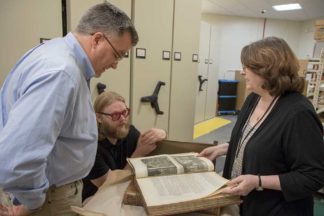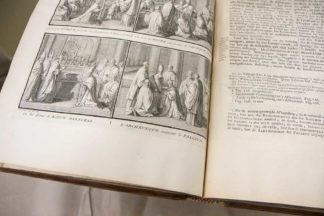Image-centric, assembled similarly to copy-and-paste, click bait-like teasers — contemporary ways of sharing information can be found in the story behind the myriad versions of Cérémonies et coutumes religieuses de tous les peuples du monde (Religious Ceremonies and Costumes of All the World’s Peoples), first published in 1723 in Amsterdam.
To gain access to versions of this valuable work held in libraries, museums, and other institutions around the world in one virtual place, a digital portal is being developed by a University team that includes Benjamin Wiggins, the Libraries’ Program Director of Digital Arts, Sciences, & Humanities, and historians J. B. Shank and Luke Freeman. Marguerite Ragnow, Curator of the James Ford Bell Library, is an advisor on the project.
Why would one book call for a portal?
Ceremonies was a “print sensation,” says J. B. Shank, Professor of History and co-founder of the University’s Mellon-funded Consortium for the Study of the Premodern World. Sensational because of its engravings by the renowned artist Bernard Picart and texts assembled from experiences around the globe by publisher Jean-Frédéric Bernard.
Yet it was not a book — not the way we think of a book today.
Ceremonies was, Shank says, “a pile of papers.”
Mutable media was common in 18th-century printing. While we typically may think of Gutenberg’s 1455 printing of the Bible — the first book mass-produced in Europe using moveable type — as the turning point in moving from manuscript copies to repeatable printing, Shank notes that disseminating works in pieces was one of several steps along the way.
Another step, the transition from wood-block printing to more precise metal-plate engraving, gave artists a new medium to create more sophisticated artworks for print. In addition, they gained more control over their work.
“Artists who had been patronized by kings and bishops” previously in a changing society no longer had to rely on them solely, Shank says: “They could get into new relationships with booksellers and publishers.”
Publishers, engravers, and booksellers began to create, Shank says, a “new kind of lavish book, often very large in size,” like Ceremonies. In order to ensure a profit, these precursors to coffee-table books were offered through subscription — with appeals one might compare to click bait — and printed as ordered.
A potential audience for Ceremonies was prepared for its revelations, Ragnow notes, particularly as the 18th century was the heart of the Enlightenment, which promoted religious tolerance.
“It also was a period of increased scientific curiosity and experimentation, one that included understanding how other peoples lived, how they thought, how they organized their societies,” Ragnow says. ”Travel narratives, works of ethnography, natural history, and geography were among the most widely published books of the early modern period and they found eager readers in all walks of life.”
Eager subscribers purchased Ceremonies, yet they also rearranged the pages and images. Some adapted, translated, or bowdlerized the work for their own ends.
“We are in a similar moment in our times, the way that digital media is blurring what is a book,” Shank says. Thus no standard Ceremonies currently exists.
The Book That Changed Europe
In 2010, The Book That Changed Europe: Picart and Bernard’s Religious Ceremonies of the World was published by scholars W. W. Mijnhardt, Margaret C. Jacob, Lynn Hunt. This team of historians, now retired and supportive of the U’s digital portal project, asserted the importance of this 18th century work on religious expression — Christian, Jewish, Islamic, Hindu, Buddhist, pagan, and indigenous peoples’ approach to the idea of the divine or a transcendent reality — within a Europe under the influence of the Enlightenment.
Still, when today’s scholars search card catalogs for this title, Shank says, the rules for maintaining records typically do not indicate the differences among copies titled Ceremonies. In 2019, the James Bell Ford Library acquired a Dutch-language edition, joining a complete French edition and one volume of an English edition held in other U of M Libraries collections.
“Adding the Dutch edition to the collection when it became available was a natural part of my job as curator,” says Ragnow. “Acquiring materials that fit the collection, filling gaps in the collection, and also adding materials to the collection that are of immediate use to researchers — this edition scored in all three of those categories.”
U people behind the digital portal
The U team began work with the team behind a UCLA website devoted to the Ceremonies. The site was innovative for its time, making several editions of Ceremonies available and offering scholarly resources about the book. But the opportunities made available by the technological advances of the last two decades led Shank to organize a team to explore the possibility of a new a digital portal. In 2018, the team received an NEH Digital Humanities Advancement Grant (DHAG) to build it.
“One of the hallmarks of modern librarianship, both in this country and around the world, is making published work openly accessible to everyone who wants it,” Ragnow says. “Digital projects such as this one are key to that effort, particularly for premodern works that are widely disbursed and require special handling when viewing them in person.”
On the team is U graduate student Luke Freeman, who has visited various existing versions of Ceremonies held around the United States and across the world. “What I’m basically doing is bibliographic hide-and-seek,” Freeman says of his travels, which because of the cost and time involved, are not an option for everyone.
Serendipity strikes
A collector for what is now the Morgan Library & Museum in New York City had written Ceremonies in her logbook a long time ago, Freeman says, but afterwards, the volumes disappeared. When he visited the Morgan Library a few months ago, however, he was surprised that the library had a full set.
“Did you buy this?” asked Freeman. “Oh no,” the library staff person said. “We just found it.”
It had been hiding, like Poe’s purloined letter, in plain sight — on the bookshelves in J. P. Morgan’s office, preserved as part of the museum. While doing an inventory, the staff re-discovered it.
“That’s kind of how the research has gone,” Freeman says, “serendipitous discoveries like that.”
Digital portal expands Ceremonies

Ben Wiggins
Wiggins points out, given the nature of the work — a multi-volume set with the many variations — each library or institution’s holding is potentially unique in some way. This being the case, he adds, how could a single scholar assess how a particular set might be unique?
“It takes a community,” Wiggins says, “to understand the images, the texts, the material culture, how it was bound, how it was censored, things like that.”
The Ceremonies digital portal would not have been possible even five years ago, Wiggins says. One pillar is the International Image Interoperability Framework (IIIF), which allows digital images in separate collections to be shared and accessed by the digital portal. Formerly, institutions asked to share such materials were stymied by issues of copyright or ownership but with IIIF, the materials remain in place, actually and virtually.
Another pillar for the digital portal for Picart and Bernard’s Ceremonies is an open-source image viewing software, Mirador, that originated at Stanford University to compare individual works of art.
“We are stretching it with multi-volume books,” Wiggins says, adding that one key element to this software is the annotation function. “Scholars can put their comments and knowledge about a feature of the text or an image directly into the file. They can tell their own stories, too.”
And stories help build connections and community, which will bolster the long-term success of this project.
It intrigues Wiggins that this U of M team is looking around the world for variations on this book that changed Europe, just as Picart and Bernard were seeking knowledge of each religion around the world.
“The meta nature of this work is not lost on me,” he says. Their vision to capture the world at one point of time now allows a community to coalesce, to compare, and to contribute new knowledge. The digital portal could be compared to a living organism that grows with annotations and spreads its influence among a scholarly community.
Says Wiggins: “This book is really infinitely unfolding.”






